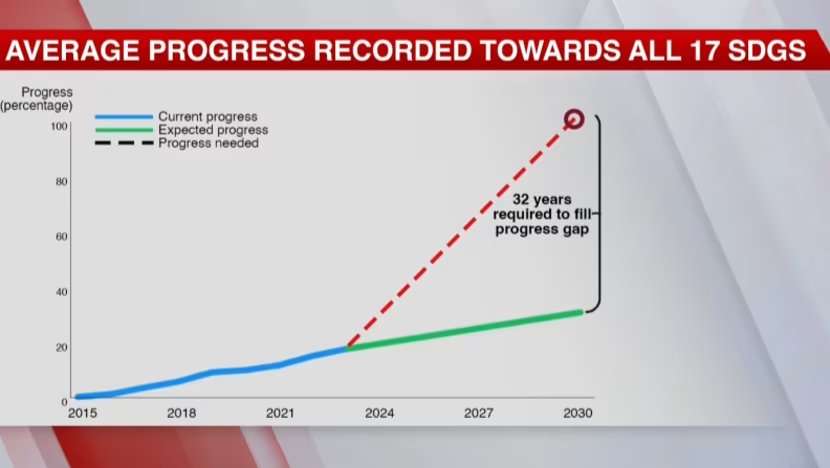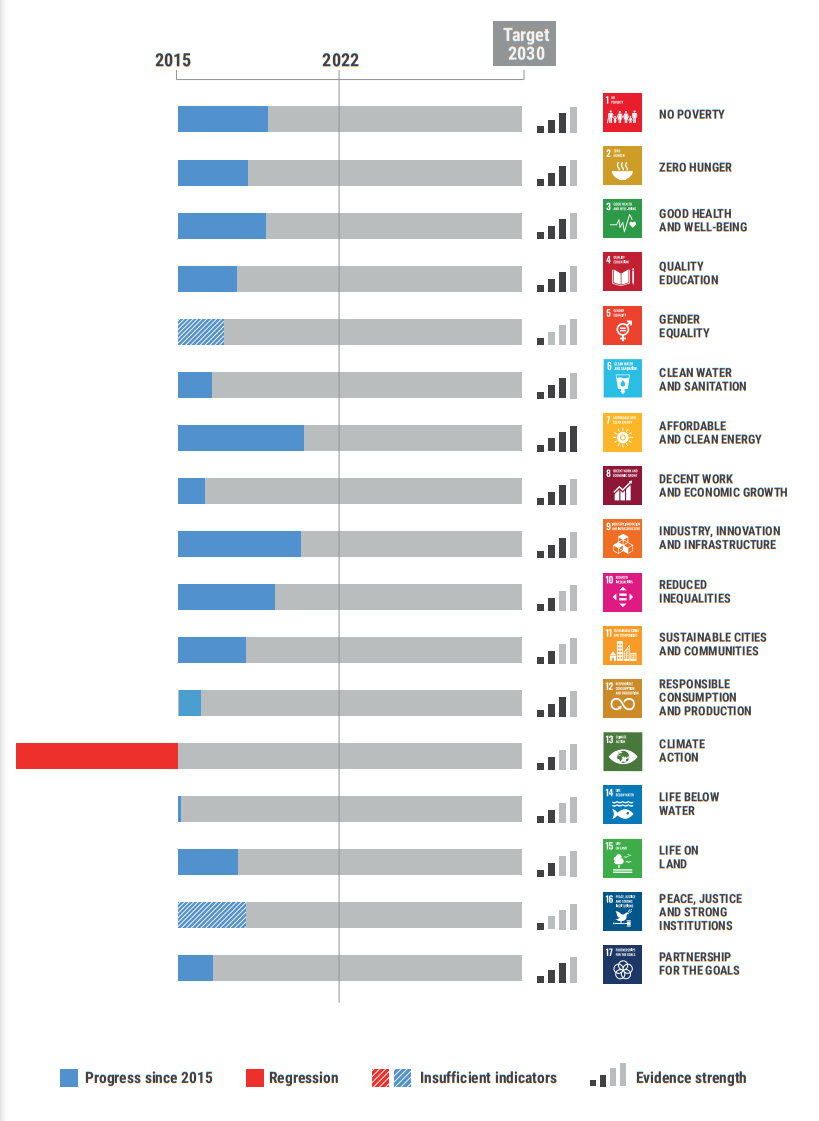Social Justice
Asia-Pacific SDG Progress Report 2024
- 21 Feb 2024
- 9 min read
For Prelims: Sustainable Development Goals (SDGs), Asia and the Pacific SDG Progress Report 2024, United Nations Economic and Social Commission for Asia and the Pacific (UNESCAP).
For Mains: Asia and the Pacific SDG Progress Report 2024, Issues relating to poverty and hunger.
Why in News?
Recently, the United Nations Economic and Social Commission for Asia and the Pacific (UNESCAP) published the Asia and the Pacific SDG Progress Report 2024. This report focuses on success stories, trends, and the distinct challenges encountered in various parts of the region in striving towards the SDGs.
What is Asia and the Pacific SDG Progress Report?
- The Asia and the Pacific SDG Progress Report is one of the annual flagship publications of the United Nations ESCAP. It provides an overview of SDG Progress in the region which serves as a foundation for many other activities conducted by ESCAP and its partners.
- It draws out the priorities for enhancing data availability on SDG indicators, especially for the most vulnerable population groups, which could help shape more equitable and inclusive development strategies.
What are the Key Highlights of the Report?
- Overall Progress Delayed:
- Progress on the 17 Sustainable Development Goals (SDGs) remains uneven and inadequate across various segments of the population and within the five subregions of Asia and the Pacific.
- At the current pace, the region will not achieve all SDGs until 2062, which marks a significant 32-year delay from the target year of 2030.
- Limited Progress on Measurable Targets:
- Only 11% of the 116 measurable SDG targets are on track. By 2030, the region is projected to achieve only one-third of the required progress if the current trajectory continues.
- Climate Action Lagging:
- Progress on SDG 13 (Climate Action) remains critically behind, with all SDG 13 targets either stalled or reversing, highlighting the urgent need to incorporate climate action into national policies and strengthen resilience to cope with climate-related disasters.
- Data Gaps Impede Monitoring:
- Close to 67% of the 169 SDG targets in the Asia-Pacific region are currently not measurable.
- 62.5% of indicators under the climate goal (SDG 13) lack the data required for monitoring progress.
- Data availability has improved since 2017 but remains insufficient for 53 targets, including three climate-related ones.
- Close to 67% of the 169 SDG targets in the Asia-Pacific region are currently not measurable.
- Gender Inequality:
- Despite overall progress in school enrolment rates, women and girls in the region continue to face considerable challenges when it comes to accessing education and employment opportunities.
- They have lower enrolment rates and struggle with literacy. Young women also encounter difficulties accessing labour markets, leading to higher rates of youth unemployment.
- Meanwhile, the challenges faced by men tend to be related to their health or personal safety.
- They suffer from higher rates of suicide, chronic diseases and road traffic deaths.
- Interconnectedness of Goals:
- Progress on goals such as ending hunger (SDG 2), enhancing health and well-being (SDG 3), ensuring clean water and sanitation (SDG 6), expanding affordable and clean energy (SDG 7), and building sustainable cities and communities (SDG 11) has also been limited.
- These goals are closely linked with Climate Change and face challenges that could disrupt progress in the region.
- Warning on Global Risks:
- Climate change and extreme weather events are identified as severe global risks over the next decade, further emphasising the importance of addressing climate action to achieve SDG targets.
- National Success Stories:
- In the Philippines, dedicated research and analysis aimed at estimating the cost of supporting children living with a disability played a pivotal role in influencing recent legislation to provide a disability allowance, extending support to children with disabilities.
- Nationwide digital training programmes in Vietnam have underscored the value of Public-Private Partnerships in accelerating digital transformation and bridging the skills and employment gap for youth and migrant workers.
- Meanwhile, in North and Central Asia, national statistical systems in Kazakhstan, Kyrgyzstan, Turkmenistan and Uzbekistan have been upgraded to better support stateless populations.
- Key Recommendations of the Report:
- There is urgency in addressing inequalities that impact marginalised groups, including women, girls, rural populations and the urban poor, who continue to find themselves locked out of education and employment opportunities.
- There is a need for a significant increase in investment in sustainable infrastructure and renewable energy sources to address the challenges posed by Climate Change and achieve various SDGs.
- India's Progress on SDG as per the Report:
- India’s overall SDG score improved by 6 points, rising from 60 in 2019 to 66 in 2020–21.
- Notable achievements include Goal 6 (Clean Water and Sanitation) and Goal 7 (Affordable and Clean Energy), with composite goal scores of 83 and 92, respectively.
United Nations Economic and Social Commission for Asia and the Pacific
- The United Nations Economic and Social Commission for Asia and the Pacific (UNESCAP) is the regional development arm of the United Nations for the Asia-Pacific region.
- It has 53 Member States and 9 Associate Members from the Asia-Pacific Region including India.
- Established: 1947
- Headquarters: Bangkok, Thailand
- Objective: To overcome some of the region’s greatest challenges by providing results-oriented projects, technical assistance and capacity building to member States.
UPSC Civil Services Examination Previous Year Question (PYQ)
Prelims
Q. Consider the following statements: (2016)
- The Sustainable Development Goals were first proposed in 1972 by a global think tank called the ‘Club of Rome’.
- The Sustainable Development Goals have to be achieved by 2030.
Which of the statements given above is/are correct?
(a) 1 only
(b) 2 only
(c) Both 1 and 2
(d) Neither 1 nor 2
Ans: (b)
Exp:
- The 17 Sustainable Development Goals (SDGs), also known as the Global Goals, are a universal call for action to end poverty, protect the planet and ensure that all people enjoy peace and prosperity.
- They are built upon the success of the Millennium Development Goals, including new areas such as climate change, economic inequality, innovation, sustainable consumption, peace and justice, among other priorities.
- The goals are interconnected – often the key to success on one will involve tackling issues more commonly associated with another.
- Adopted in 2015, SDGs came into effect in January 2016. They are meant to be achieved by 2030. Hence, statement 2 is correct.
- The SDGs were born at the United Nations Conference on Sustainable Development in Rio de Janeiro in 2012. The Club of Rome advocated resource conservation for the first time in a more systematic way in 1968. Hence, statement 1 is not correct. Therefore, option (b) is the correct answer.
Mains
Q. Access to affordable, reliable, sustainable and modern energy is the sine qua non to achieve Sustainable Development Goals (SDGs).” Comment on the progress made in India in this regard. (2018)
Q. National Education Policy 2020 isin conformity with the Sustainable Development Goal-4 (2030). It intends to restructure and reorient education system in India. Critically examine the statement. (2020)






